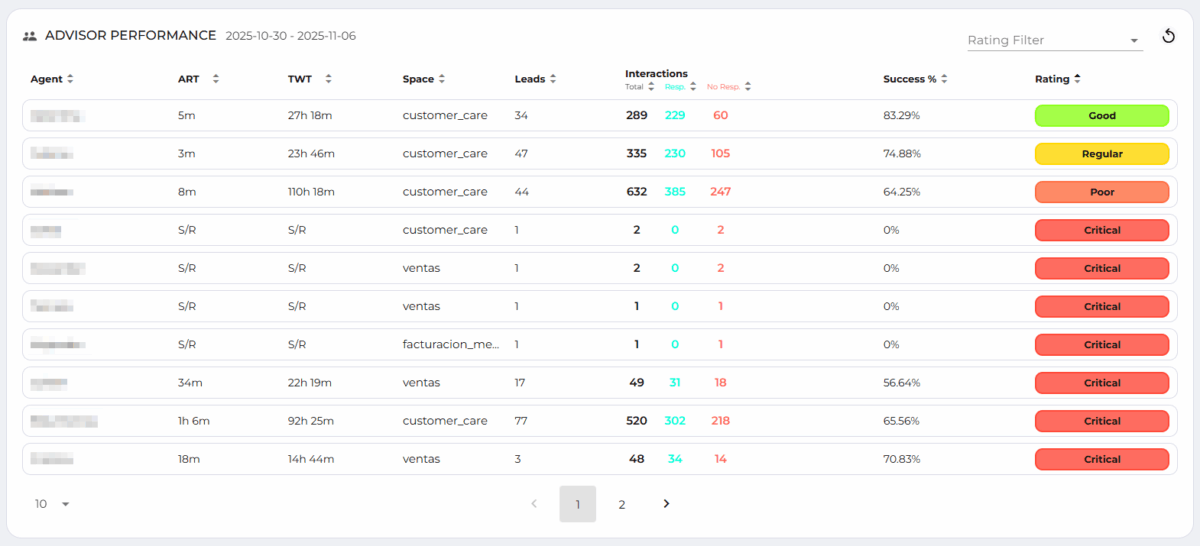Empathy Protocol: A Strategic Guide for Customer Service Excellence Developed by Biky.ai

Evaluate your team fairly: the Empathy Protocol gives you 6 strata, clear success rates, and timing metrics for leaders who want sustainable performance. More clarity, less burnout; better results.
Leading a customer service team today is not just about measuring response times or reviewing satisfaction surveys. It’s about managing an operation that represents the voice of the brand in every interaction.
Every second counts, every word leaves an impression, and every interaction can define whether a customer stays or leaves. In this scenario, traditional performance evaluation systems often fall short.
Many models measure only speed or script compliance, without considering something essential: workload context. Fortunately, at Biky.ai, we have developed the Empathy Protocol, a framework designed to change that.
This system introduces Stratified Analysis, a methodology that adjusts evaluation metrics according to each agent’s workload volume. It’s a technical approach with a human heart — recognizing that excellence isn’t measured only in seconds, but in the balance between performance, quality, and empathy.
For leaders, this is not just a control tool. It’s a guide to building fairer, more committed, and more sustainable teams.

Why Traditional Models Fail
In most contact centers, leaders face the same dilemma: how to maintain high metrics without burning out the team.
Conventional systems punish mistakes and reward speed but fail to measure contextual complexity.
An agent handling a few chats can easily maintain a 20-second response time, while another managing 25 simultaneous conversations struggles to respond in under seven minutes. If both are evaluated with the same metric, the result is unfair: one looks excellent, and the other inefficient—when in reality, both are performing optimally within their circumstances.
This type of biased evaluation causes:
- Demotivation and turnover: agents feel they can never meet expectations.
- Distorted quality reports: numbers don’t reflect real effort.
- Leadership burnout: supervisors end up justifying metrics that lack context.
The Empathy Protocol corrects this imbalance with a simple logic: it’s not about demanding the same from everyone, but about measuring performance according to each person’s reality.
The Heart of the Empathy Protocol: Stratified Analysis
Stratified Analysis is a statistical method that divides agents into different groups (strata) based on their workload volume.
Each level has distinct parameters for two key metrics:
- Success Rate (messages responded ÷ total messages × 100)
- Average Response Time (time between the client’s message and the agent’s response).
Each stratum is evaluated as follows:
Stratum 1: Very Low Volume (<5 chats)
Strict criteria — with low volume, we expect excellence
| Rating | % Success | Max. Response Time |
| Excellent | ≥ 98% | ≤ 0.33 min (20 sec) |
| Very Good | ≥ 95% | ≤ 0.66 min (40 sec) |
| Good | ≥ 90% | ≤ 1 min |
| Acceptable | ≥ 85% | ≤ 1.5 min |
| Regular | ≥ 75% | ≤ 2 min |
| Deficient | ≥ 65% | ≤ 3 min |
| Poor | ≥ 55% | ≤ 4 min |
| Critical | < 55% | > 4 min |
Stratum 2: Low Volume (5–9 chats)
High criteria — low volume, high expectations
| Rating | % Success | Max. Response Time |
| Excellent | ≥ 96% | ≤ 1 min |
| Very Good | ≥ 92% | ≤ 2 min |
| Good | ≥ 88% | ≤ 3 min |
| Acceptable | ≥ 83% | ≤ 4 min |
| Regular | ≥ 75% | ≤ 5 min |
| Deficient | ≥ 65% | ≤ 6 min |
| Poor | ≥ 55% | ≤ 7 min |
| Critical | < 55% | > 7 min |
Stratum 3: Low-Medium Volume (10–14 chats)
Balanced-high criteria — moderate volume, balanced expectations
| Rating | % Success | Max. Response Time |
| Excellent | ≥ 95% | ≤ 2 min |
| Very Good | ≥ 90% | ≤ 3 min |
| Good | ≥ 85% | ≤ 4 min |
| Acceptable | ≥ 80% | ≤ 5 min |
| Regular | ≥ 72% | ≤ 6 min |
| Deficient | ≥ 62% | ≤ 7 min |
| Poor | ≥ 52% | ≤ 8 min |
| Critical | < 52% | > 8 min |
Stratum 4: Medium Volume (15–19 chats)
Balanced criteria — with medium volume, we apply fair standards
| Rating | % Success | Max. Response Time |
| Excellent | ≥ 94% | ≤ 4 min |
| Very Good | ≥ 88% | ≤ 5 min |
| Good | ≥ 83% | ≤ 6 min |
| Acceptable | ≥ 78% | ≤ 7 min |
| Regular | ≥ 70% | ≤ 8 min |
| Deficient | ≥ 60% | ≤ 9 min |
| Poor | ≥ 50% | ≤ 10 min |
| Critical | < 50% | > 10 min |
Stratum 5: Medium-High Volume (20–24 chats)
Balanced-flexible criteria — with higher volume, we recognize the challenge
| Rating | % Success | Max. Response Time |
| Excellent | ≥ 92% | ≤ 6 min |
| Very Good | ≥ 85% | ≤ 7 min |
| Good | ≥ 80% | ≤ 8 min |
| Acceptable | ≥ 75% | ≤ 9 min |
| Regular | ≥ 68% | ≤ 10 min |
| Deficient | ≥ 58% | ≤ 11 min |
| Poor | ≥ 48% | ≤ 12 min |
| Critical | < 48% | > 12 min |
Stratum 6: High Volume (≥25 chats)
Flexible criteria — with very high volume, we value your effort
| Rating | % Success | Max. Response Time |
| Excellent | ≥ 90% | ≤ 7 min |
| Very Good | ≥ 85% | ≤ 8 min |
| Good | ≥ 80% | ≤ 9 min |
| Acceptable | ≥ 75% | ≤ 10 min |
| Regular | ≥ 68% | ≤ 11 min |
| Deficient | ≥ 58% | ≤ 12 min |
| Poor | ≥ 48% | ≤ 13 min |
| Critical | < 48% | > 13 min |
Each level recognizes the operational difficulty: the higher the volume, the more flexibility; the lower the volume, the higher the expectation. This allows a fair, proportional, and comparative evaluation without losing rigor.
This is an illustrative example of how your sales team’s performance will appear in Biky.ai Metrics, enabling smart decision-making for continuous improvement.

Transition Messages: The Turning Point
One of the most innovative pillars of the system to solve wait times in agent management is the use of smart transition messages.
These messages not only keep the conversation active but also optimize metrics.
When an agent needs to verify information, instead of staying silent, they can say:
- “Let me check that for you and confirm right away.”
- “I’m going to verify that so I can give you the exact answer.”
With this method, the system counts the first message as a response, granting up to five minutes of margin to research without affecting the metric.
For leaders, this represents a cultural shift: training teams to communicate while they work, avoiding silences that impact both the customer and the indicators.
The result:
- Informed, reassured customers.
- Optimized response time metrics.
- Reduced operational pressure.
The Leader’s Role within the Protocol
Implementing the Empathy Protocol transforms the supervisor’s role. They stop being “metric controllers” and become performance mentors.
The leader no longer just reviews dashboards; they interpret data within each agent’s operational context.
Key actions include:
- Identify individual patterns:
If an agent in Stratum 5 (20–24 chats) maintains an average response time of 4 minutes, they’re exceeding standards. Conversely, if someone in Stratum 2 takes more than 3 minutes, improvement is needed in prioritization or focus. - Give feedback with empathy and precision:
The conversation shifts from “your response time is high” to “I see your load of 20 chats is demanding; let’s use more effective transition messages to gain seconds.” - Detect operational overload before it’s visible:
If an agent’s success rate drops and response time rises, the leader can determine whether it’s due to training, time management, or simple saturation. - Celebrate achievements meaningfully:
An agent in Stratum 6 maintaining 90% success across 25 simultaneous chats is operating at the highest performance level. Recognizing that fosters pride and retention.
Comparative Cases: When Context Changes Everything
- Case 1: Stratum 2 – 8 active chats
Goal: ≥96% success | ≤1 min response
Moderate load — must prioritize speed. With good time management and transition messages, can maintain excellent ratings. - Case 2: Stratum 5 – 22 active chats
Goal: ≥92% success | ≤6 min response
Challenge: simultaneity. Focus should be strategic—quick initial replies, effective transitions, constant prioritization. - Case 3: Stratum 6 – 27 active chats
Goal: ≥90% success | ≤7 min response
This level requires calm under pressure. Agents meeting these standards demonstrate operational mastery and emotional balance—high-performance profiles that should be publicly recognized by leadership.
Indicators for Intelligent Supervision
The protocol recommends leaders monitor three levels of data:
- Daily:
- Average response times
- Individual success rate
- Agents outside their ideal range
- Average response times
- Weekly:
- Performance evolution by stratum
- Chat load changes and impact on quality
- Detection of fatigue patterns
- Performance evolution by stratum
- Monthly:
- Comparison between strata
- Evaluation of sustained improvement
- Correlation with NPS, CSAT, and retention metrics
- Comparison between strata
This way, leaders stop reading just a number and start reading an operational story. Each data point becomes a development conversation, not a punishment.

Impact on Work Culture and Results
Implementing the Empathy Protocol generates three direct and measurable impacts:
- Increased internal motivation:
Agents perceive fairness — those with heavier workloads aren’t punished; those with lighter loads know more precision is expected. - Reduced emotional strain:
By eliminating unfair comparisons, team tension decreases and work climate improves. - Improved overall performance:
Metrics rise because the rules are clear. A motivated, well-guided agent responds better, faster, and with more empathy.
Conclusion
The Empathy Protocol redefines what it means to evaluate performance in customer service. It’s not just a technical system — it’s a leadership philosophy.
It allows leaders to measure fairly, lead with empathy, and maintain operational excellence without sacrificing the human factor.
For leaders, it’s an opportunity: to stop being evaluators of metrics and become builders of sustainable performance.
Because the best results come not from pressure, but from clarity, coherence, and trust.
Ultimately, leading under this protocol is not just about applying a new method — it’s about raising the standard for how we understand human work within service teams.